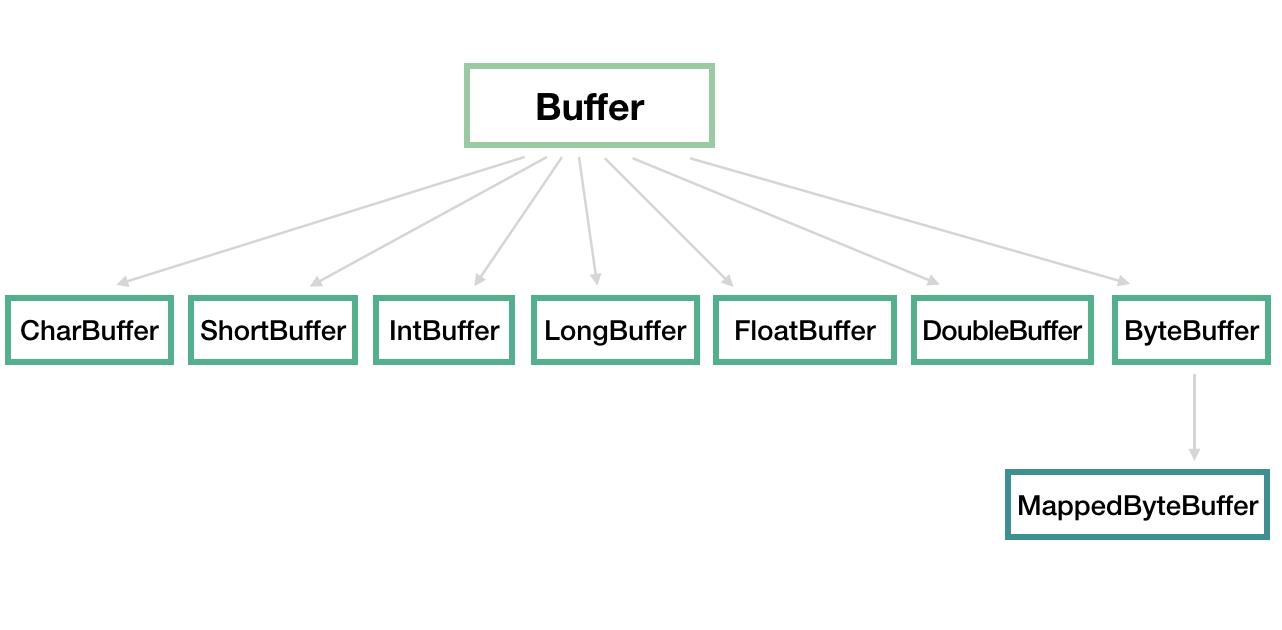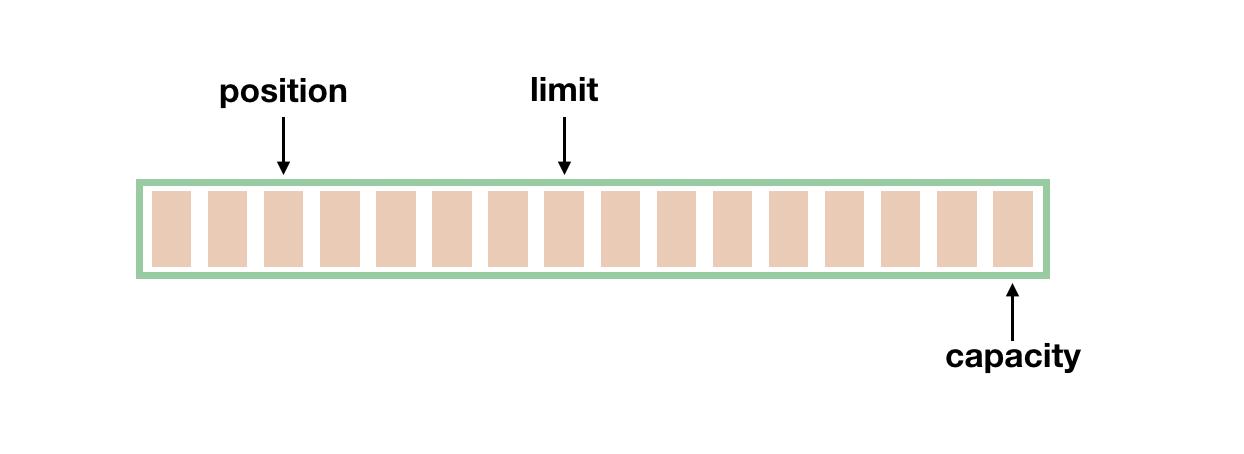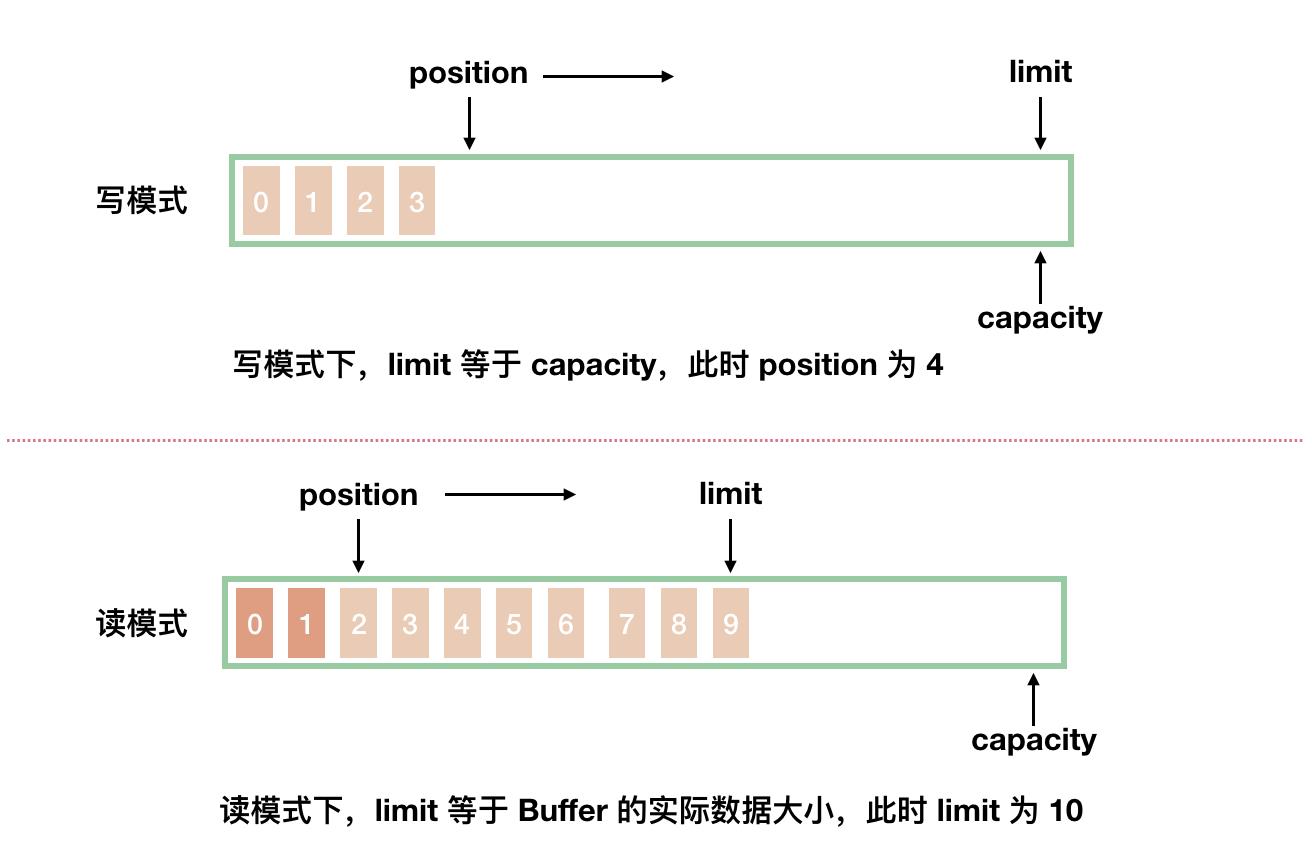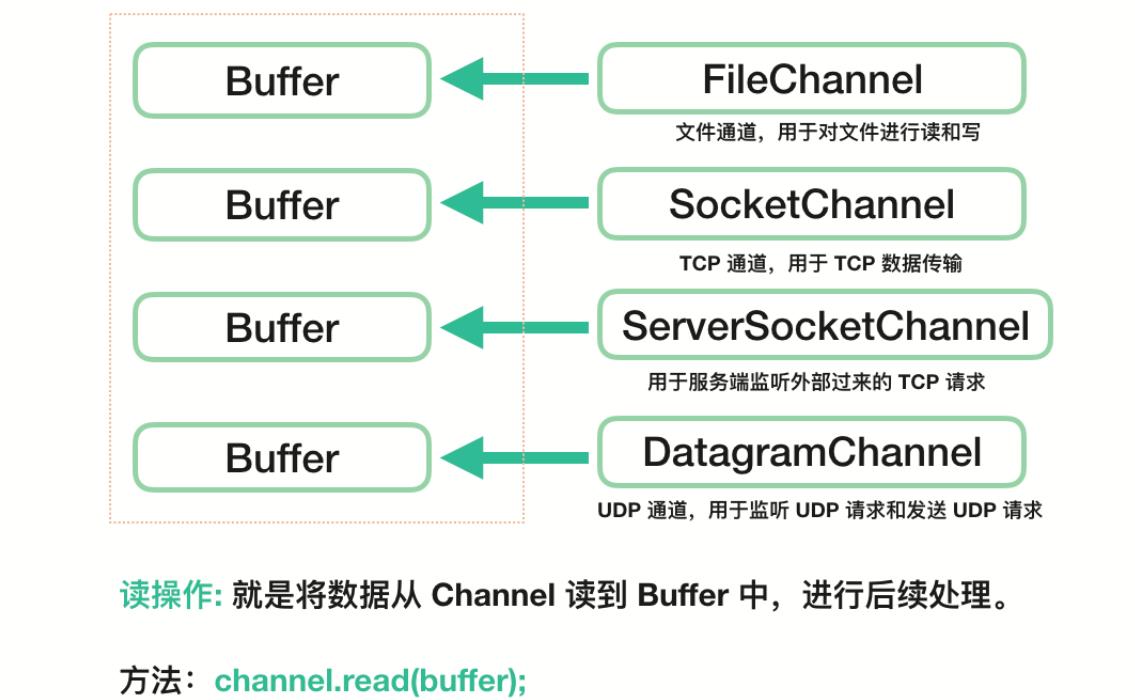Java NIO:BufferChannel 和 Selector
Posted 卫旗
tags:
篇首语:本文由小常识网(cha138.com)小编为大家整理,主要介绍了Java NIO:BufferChannel 和 Selector相关的知识,希望对你有一定的参考价值。
Buffer
一个 Buffer 本质上是内存中的一块,我们可以将数据写入这块内存,之后从这块内存获取数据。
java.nio 定义了以下几个 Buffer 的实现,这个图读者应该也在不少地方见过了吧。

其实核心是最后的 ByteBuffer,前面的一大串类只是包装了一下它而已,我们使用最多的通常也是 ByteBuffer。
我们应该将 Buffer 理解为一个数组,IntBuffer、CharBuffer、DoubleBuffer 等分别对应 int[]、char[]、double[] 等。
MappedByteBuffer 用于实现内存映射文件,也不是本文关注的重点。
我觉得操作 Buffer 和操作数组、类集差不多,只不过大部分时候我们都把它放到了 NIO 的场景里面来使用而已。下面介绍 Buffer 中的几个重要属性和几个重要方法。
position、limit、capacity
就像数组有数组容量,每次访问元素要指定下标,Buffer 中也有几个重要属性:position、limit、capacity。

最好理解的当然是 capacity,它代表这个缓冲区的容量,一旦设定就不可以更改。比如 capacity 为 1024 的 IntBuffer,代表其一次可以存放 1024 个 int 类型的值。一旦 Buffer 的容量达到 capacity,需要清空 Buffer,才能重新写入值。
position 和 limit 是变化的,我们分别看下读和写操作下,它们是如何变化的。
position 的初始值是 0,每往 Buffer 中写入一个值,position 就自动加 1,代表下一次的写入位置。读操作的时候也是类似的,每读一个值,position 就自动加 1。
从写操作模式到读操作模式切换的时候(flip),position 都会归零,这样就可以从头开始读写了。
limit:写操作模式下,limit 代表的是最大能写入的数据,这个时候 limit 等于 capacity。写结束后,切换到读模式,此时的 limit 等于 Buffer 中实际的数据大小,因为 Buffer 不一定被写满了。

初始化 Buffer
每个 Buffer 实现类都提供了一个静态方法 allocate(int capacity) 帮助我们快速实例化一个 Buffer。如:
ByteBuffer byteBuf = ByteBuffer.allocate(1024); IntBuffer intBuf = IntBuffer.allocate(1024); LongBuffer longBuf = LongBuffer.allocate(1024);
另外,我们经常使用 wrap 方法来初始化一个 Buffer。
public static ByteBuffer wrap(byte[] array) {
...
}
填充 Buffer
各个 Buffer 类都提供了一些 put 方法用于将数据填充到 Buffer 中,如 ByteBuffer 中的几个 put 方法:
// 填充一个 byte 值
public abstract ByteBuffer put(byte b);
// 在指定位置填充一个 int 值
public abstract ByteBuffer put(int index, byte b);
// 将一个数组中的值填充进去
public final ByteBuffer put(byte[] src) {...}
public ByteBuffer put(byte[] src, int offset, int length) {...}
上述这些方法需要自己控制 Buffer 大小,不能超过 capacity,超过会java.nio.BufferOverflowException 异常。
对于 Buffer 来说,另一个常见的操作中就是,我们要将来自 Channel 的数据填充到 Buffer 中,在系统层面上,这个操作我们称为读操作,因为数据是从外部(文件或网络等)读到内存中。
int num = channel.read(buf);
上述方法会返回从 Channel 中读入到 Buffer 的数据大小。
提取 Buffer 中的值
前面介绍了写操作,每写入一个值,position 的值都需要加 1,所以 position 最后会指向最后一次写入的位置的后面一个,如果 Buffer 写满了,那么 position 等于 capacity(position 从 0 开始)。
如果要读 Buffer 中的值,需要切换模式,从写入模式切换到读出模式。注意,通常在说 NIO 的读操作的时候,我们说的是从 Channel 中读数据到 Buffer 中,对应的是对 Buffer 的写入操作,初学者需要理清楚这个。
调用Buffer的flip()方法,可以从写模式切换到读模式,其实就是重新设置了一下position和limit的值。
public final Buffer flip() {
limit = position; // 将 limit 设置为实际写入的数据数量
position = 0; // 重置 position 为 0
mark = -1; // mark 之后再说
return this;
}
对应写操作的一系列put方法,读操作提供了一系列的get()方法:
// 根据 position 来获取数据 public abstract byte get(); // 获取指定位置的数据 public abstract byte get(int index); // 将 Buffer 中的数据写入到数组中 public ByteBuffer get(byte[] dst)
附一个经常使用的方法:
new String(buffer.array()).trim();
除了将数据从Buffer读取出来使用,更常见的操作是将写入的数据输出到Channel中,如通过FileChannel将数据写入到文件中,通过SocketChannel将数据写入到网络发送到远程机器等。对应的,这种操作,我们称之为写操作。
int num = channel.write(buf);
mark()、reset()
除了position、limit、capacity这三个基本属性外,还有一个常用的属性就是mark。
mark用于临时保存position的值,每次调用mark()方法都会将mark设置为当前的position,便于后学需要的时候使用。
public final Buffer mark() {
mark = position;
return this;
}
那到底什么时候用呢?考虑以下场景,我们在 position 为 5 的时候,先 mark() 一下,然后继续往下读,读到第 10 的时候,我想重新回到 position 为 5 的地方重新来一遍,那只要调一下 reset() 方法,position 就回到 5 了。
public final Buffer reset() {
int m = mark;
if (m < 0)
throw new InvalidMarkException();
position = m;
return this;
}
rewind()、clear()、compact()
rewind():会重置position为0,通常用于从头读写Buffer。
public final Buffer rewind() {
position = 0;
mark = -1;
return this;
}
clear():相当于重新实例化。
通常,我们会先填充Buffer,然后从Buffer读取数据,之后再重新往里填充新的数据,我们一般在填充之前先调用clear().
public final Buffer clear() {
position = 0;
limit = capacity;
mark = -1;
return this;
}
compact():和clear()一样的是都是在准备往Buffer中填充新数据之前调用。
clear()会重置几个属性,但是并不会将Buffer中的数据清空,只不过后面写的时候会覆盖之前的数据。
而compact()方法调用之后,会先处理还没有读取的数据,也就是position到limit直接的数据,先将这些数据都移动到左边,然后在这个基础之上再开始写入。此时,limit还是等于capacity,position指向原来数据的右边。
Channel
所有的 NIO 操作始于通道,通道是数据来源或数据写入的目的地,主要地,我们将关心 java.nio 包中实现的以下几个 Channel:

FileChannel:文件通道,用于文件的读和写。
DatagramChannel:用于UDP连接的接收和发送
SocketChannel:TCP客户端
ServerSocketChannel:TCP服务端,监听某个端口进来的请求。
Channel 经常翻译为通道,类似 IO 中的流,用于读取和写入。它与前面介绍的 Buffer 打交道,读操作的时候将 Channel 中的数据填充到 Buffer 中,而写操作时将 Buffer 中的数据写入到 Channel 中。


FileChannel
初始化:
FileInputStream inputStream = new FileInputStream(new File("/data.txt"));
FileChannel fileChannel = inputStream.getChannel();
当然了,也可以从RandomAccessFile类中的getChannel来得到FileChannel。
读取文件内容:
ByteBuffer buffer = ByteBuffer.allocate(1024); int num = fileChannel.read(buffer);
写入文件内容:
ByteBuffer buffer = ByteBuffer.allocate(1024);
buffer.put("随机写入一些内容到 Buffer 中".getBytes());
// Buffer 切换为读模式
buffer.flip();
while(buffer.hasRemaining()) {
// 将 Buffer 中的内容写入文件
fileChannel.write(buffer);
}
SocketChannel
打开一个TCP链接:
SocketChannel socketChannel = SocketChannel
.open(new InetSocketAddress("127.0.0.1", 80));
当然了,上面的这行代码等价于下面的两行:
// 打开一个通道
SocketChannel socketChannel = SocketChannel.open();
// 发起连接
socketChannel.connect(new InetSocketAddress("127.0.0.1", 80));
SocketChannel 的读写和 FileChannel 没什么区别,就是操作缓冲区。
// 读取数据
socketChannel.read(buffer);
// 写入数据到网络连接中
while(buffer.hasRemaining()) {
socketChannel.write(buffer);
}
ServerSocketChannel
ServerSocketChannel 用于监听机器端口,管理从这个端口进来的 TCP 连接。
// 实例化
ServerSocketChannel serverSocketChannel = ServerSocketChannel.open();
// 监听 8080 端口
serverSocketChannel.socket().bind(new InetSocketAddress(8080));
while (true) {
// 一旦有一个 TCP 连接进来,就对应创建一个 SocketChannel 进行处理
SocketChannel socketChannel = serverSocketChannel.accept();
}
这里我们看到了SocketChannel的第二个实例化方式。
到这里,我们应该能理解SocketChannel了,它不仅仅是TCP客户端,它代表的是一个网络通道,可读可写。
ServerSocketChannel不和Buffer打交道了,因为它并不实际处理数据,一旦接到请求,就会实例化一个SocketChannel,之后再这个简介通道上传递的数据它就不管了,它会继续监听端口等待下一个连接。
DatagramChannel
UDP 和 TCP 不一样,DatagramChannel 一个类处理了服务端和客户端。
UDP 是面向无连接的,不需要和对方握手,不需要通知对方,就可以直接将数据包投出去,至于能不能送达,它是不知道的.
监听端口:
DatagramChannel channel = DatagramChannel.open(); channel.socket().bind(new InetSocketAddress(9090)); ByteBuffer buf = ByteBuffer.allocate(48); channel.receive(buf);
发送数据:
String newData = "New String to write to file..."
+ System.currentTimeMillis();
ByteBuffer buf = ByteBuffer.allocate(48);
buf.put(newData.getBytes());
buf.flip();
int bytesSent = channel.send(buf, new InetSocketAddress("jenkov.com", 80));
Selector
Selector建立在非阻塞的基础之上,大家经常听到的多路复用在java世界中指的就是它,用于实现一个线程管理多个Channel。
开启Selector:
Selector selector = Selector.open();
将 Channel 注册到 Selector 上。前面我们说了,Selector 建立在非阻塞模式之上,所以注册到 Selector 的 Channel 必须要支持非阻塞模式,FileChannel 不支持非阻塞,我们这里讨论最常见的 SocketChannel 和 ServerSocketChannel。
// 将通道设置为非阻塞模式,因为默认都是阻塞模式的 channel.configureBlocking(false); // 注册 SelectionKey key = channel.register(selector, SelectionKey.OP_READ);
register 方法的第二个 int 型参数(使用二进制的标记位)用于表明需要监听哪些感兴趣的事件,共以下四种事件:
SelectionKey.OP_READ:对应 00000001,通道中有数据可以进行读取
SelectionKey.OP_WRITE:对应 00000100,可以往通道中写入数据
SelectionKey.OP_CONNECT:对应 00001000,成功建立 TCP 连接
SelectionKey.OP_ACCEPT:对应 00010000,接受 TCP 连接
我们可以同时监听一个 Channel 中的发生的多个事件,比如我们要监听 ACCEPT 和 READ 事件,那么指定参数为二进制的 00010001 即十进制数值 17 即可。
注册方法返回值是 SelectionKey 实例,它包含了 Channel 和 Selector 信息,也包括了一个叫做 Interest Set 的信息,即我们设置的我们感兴趣的正在监听的事件集合。
调用 select() 方法获取通道信息。用于判断是否有我们感兴趣的事件已经发生了。
示例:
Selector selector = Selector.open();
channel.configureBlocking(false);
SelectionKey key = channel.register(selector, SelectionKey.OP_READ);
while(true) {
// 判断是否有事件准备好
int readyChannels = selector.select();
if(readyChannels == 0) continue;
// 遍历
Set<SelectionKey> selectedKeys = selector.selectedKeys();
Iterator<SelectionKey> keyIterator = selectedKeys.iterator();
while(keyIterator.hasNext()) {
SelectionKey key = keyIterator.next();
if(key.isAcceptable()) {
// a connection was accepted by a ServerSocketChannel.
} else if (key.isConnectable()) {
// a connection was established with a remote server.
} else if (key.isReadable()) {
// a channel is ready for reading
} else if (key.isWritable()) {
// a channel is ready for writing
}
keyIterator.remove();
}
}
对于Selector,需要熟悉以下几个方法:
select()
调用此方法,会将上次 select 之后的准备好的 channel 对应的 SelectionKey 复制到 selected set 中。如果没有任何通道准备好,这个方法会阻塞,直到至少有一个通道准备好。
selectNow()
功能和 select 一样,区别在于如果没有准备好的通道,那么此方法会立即返回 0。
select(long timeout)
看了前面两个,这个应该很好理解了,如果没有通道准备好,此方法会等待一会
wakeup()
这个方法是用来唤醒等待在 select() 和 select(timeout) 上的线程的。如果 wakeup() 先被调用,此时没有线程在 select 上阻塞,那么之后的一个 select() 或 select(timeout) 会立即返回,而不会阻塞,当然,它只会作用一次。
调
用 Buffer 的 flip() 方法,可以从写入模式切换到读取模式。其实这个方法也就是设置了一下 position 和 limit 值罢了
以上是关于Java NIO:BufferChannel 和 Selector的主要内容,如果未能解决你的问题,请参考以下文章